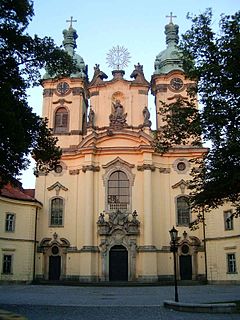| Mikołajowice | ||
|---|---|---|
| Village | ||
| ||
| Coordinates: 51°8′N16°17′E / 51.133°N 16.283°E | ||
| Country | ||
| Voivodeship | Lower Silesian | |
| County | Legnica County | |
| Gmina | Legnickie Pole | |
Mikołajowice [mikɔwajɔˈvit͡sɛ] (German : Nikolstadt) is a village in the administrative district of Gmina Legnickie Pole, within Legnica County, Lower Silesian Voivodeship, in south-western Poland. [1] Prior to 1945 it was in Germany. It lies approximately 3 kilometres (2 mi) south-east of Legnickie Pole, 13 km (8 mi) south-east of Legnica, and 53 km (33 mi) west of the regional capital Wrocław.

German is a West Germanic language that is mainly spoken in Central Europe. It is the most widely spoken and official or co-official language in Germany, Austria, Switzerland, South Tyrol (Italy), the German-speaking Community of Belgium, and Liechtenstein. It is also one of the three official languages of Luxembourg and a co-official language in the Opole Voivodeship in Poland. The languages which are most similar to German are the other members of the West Germanic language branch: Afrikaans, Dutch, English, the Frisian languages, Low German/Low Saxon, Luxembourgish, and Yiddish. There are also strong similarities in vocabulary with Danish, Norwegian and Swedish, although those belong to the North Germanic group. German is the second most widely spoken Germanic language, after English.
Gmina Legnickie Pole is a rural gmina in Legnica County, Lower Silesian Voivodeship, in south-western Poland. Its seat is the village of Legnickie Pole, which lies approximately 10 kilometres (6 mi) south-east of Legnica, and 56 kilometres (35 mi) west of the regional capital Wrocław. The gmina covers an area of 85.37 square kilometres (33.0 sq mi), and as of 2006 its total population is 4955.

Legnica County is a unit of territorial administration and local government (powiat) in Lower Silesian Voivodeship, south-western Poland. It came into being on January 1, 1999, as a result of the Polish local government reforms passed in 1998. The county covers an area of 744.6 square kilometres (287.5 sq mi). Its administrative seat is the city of Legnica, although this city is not part of the county. The only towns in Legnica County are Chojnów and Prochowice.








